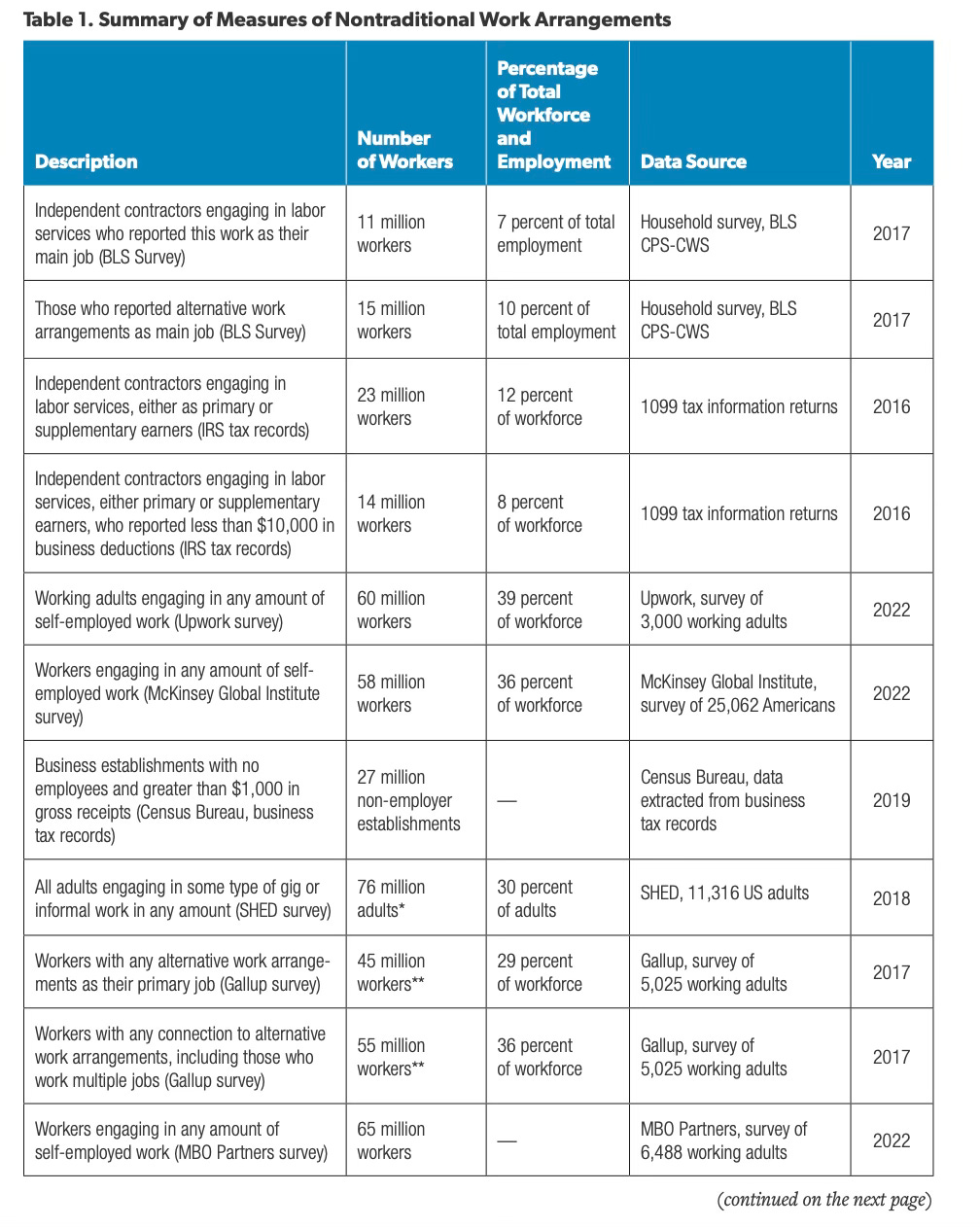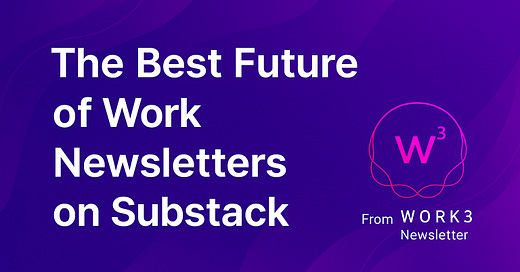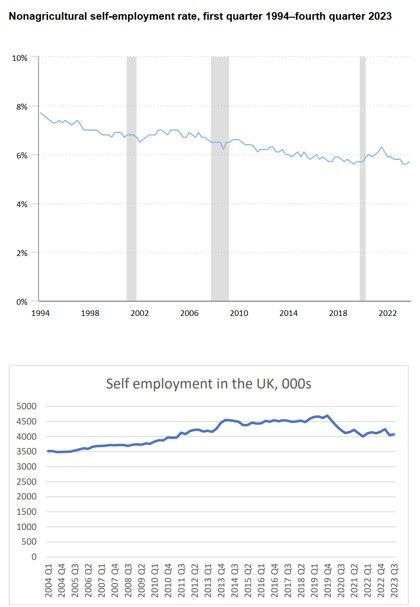The Best Future of Work Newsletters on Substack - Part 2
the smartest newsletters reshaping how we think about work
It takes a healthy discovery ecosystem to grow a newsletter community.
In Part 2 of our best newsletters on Substack, we cover the eight fallacies of AI and Work, the difficulty of measuring the gig economy, the key for successful digital transformation, a deeper look at AI transformation of Financial and Professional services and finally, what hermeneutic labour is—and what it means for the future of work.
The newsletters featured here are mostly free to read, and all are written by thinkers who publish regularly and help us ask better questions about the future we're building.
👇 Let us know in the comments — which are your favourite newsletters that explore the future of work?
The many fallacies of 'AI won't take your job, but someone using AI will' - Platforms, AI, and the Economics of BigTech - Sangeet Paul Choudary
Sangeet has literally written the book on Platform Strategy.
In his latest article, The many fallacies of 'AI won't take your job, but someone using AI will' he rips apart some of the myths about the future of work by outlining 8 fallacies.
Just learn the right tools, and you’ll stay ahead. (from Fallacy #1)
Fallacy #1: The automation vs augmentation fallacy.
AI (automation) won't take your job, but someone using AI (augmentation) will.
Indeed, this misses the point, because,
AI doesn’t simply replace tasks. It reshapes the architecture of the system in which those tasks used to make sense.
Absolutely.
Fallacy #2: The productivity gains fallacy
“AI helps me get more done, so I’ll be more valuable.”
But alas,
Value accrues not to the most productive participant, but to the one controlling the scarcest complementary asset.
Fallacy #3: The static jobs fallacy
Fallacy #4: The ‘me vs someone-using-AI’ competition fallacy
Fallacy #5: The workflow continuity fallacy
Fallacy #6: The neutral tools fallacy
Fallacy #7: The stable salary fallacy
Fallacy #8: The stable firm fallacy
I start many of my speeches on digital transformation, future of work, AI on myth-busting and you will not read a critique as sharp as this.
Read more here.
A Fresh Look at the Independent Workforce - Labor Market Matters - Liya Palagashvili
Liya Palagashvili is an economist at George Mason University and writes Labor Market Matters. Browsing the newsletter, I suspect that Liya crunches labour market data before she has breakfast in the morning. Speaking of workforce fallacies, I sometimes find it comforting to have a Labour Economist in the room - admittedly to fuel my confirmation bias.
One of my favourite evidence-based workforce myth busters is Professor Rob Briner, who recently asked,
𝗔𝗿𝗲 𝘄𝗼𝗿𝗸𝗲𝗿𝘀 𝗶𝗻𝗰𝗿𝗲𝗮𝘀𝗶𝗻𝗴𝗹𝘆 𝗺𝗼𝘃𝗶𝗻𝗴 𝗮𝘄𝗮𝘆 𝗳𝗿𝗼𝗺 𝘁𝗿𝗮𝗱𝗶𝘁𝗶𝗼𝗻𝗮𝗹 𝗷𝗼𝗯𝘀 𝗮𝗻𝗱 𝗶𝗻𝘁𝗼 𝘀𝗲𝗹𝗳-𝗲𝗺𝗽𝗹𝗼𝘆𝗺𝗲𝗻𝘁?
Rob cites the US non-agricultural self-employment rate was 5.7 percent in fourth quarter 2023, as you can see, this is trending down from over 7% in the 1990s.
he also adds that UK self-employment data is trending downwards too.
If I am feeling generous on this side of the argument that the gig economy is over-hyped, I might throw in another source - the EU recently reported the highest employment levels since 2005, nearly 71%.
So given this, a sensible conclusion to whether we’re all leaving our jobs to be self-employed is a glib: “Not really.”
However, this might not give the full picture…
A study in 2023, by Upwork reported that 64 million Americans performed freelance work during that year, representing 38% of the entire U.S. workforce. Measuring the extent of non-traditional work arrangements is tricky as the table below shows.

Liya Palagashvili’s article, A Fresh Look at the Independent Workforce with New BLS Data, looks at the latest The Contingent and Alternative Worker Supplement (referred to as the CWS), which provides an official estimate on the size and characteristics of the independent workforce.
It raises some interesting points on the difficulty of measuring labour market activity.
Approximately 11.9 million workers, or 7.4% of total U.S. employment, identified as independent contractors on their sole or main job, an increase from 6.9% in 2017. However, this understates the true size of the independent workforce since it’s only reporting on workers who use independent work as their primary source of income.
The largest share of independent contractors are supplemental earners, especially those who use apps such as Uber, Lyft, DoorDash, and Instacart.
Liya estimates the size of the independent workforce likely ranges from 11.9 million on the low end to 65 million on the high end.
I want to dig deeper here, but if you are interested in actual Gig Economy participation and the difficulties of measuring it, then,
Read more here.
People. - The Future Does Not Fit in Containers of the Past - Rishad Tobaccowala
In most discussions about the future of work, people take a much-hyped trend and then apply it vigorously to a management practice inherited from the 20th century.
Thankfully, The future Does Not Fit In Containers of the Past - which also wins the prize for the best named newsletter in the field. This is an elegant and insightful guide to the future, published by Rishad Tobaccowala - author of Rethinking Work.
In our obsession about AI, we sometimes forget that it was people who built AI engines, people who creatively prompt the machines, people who will be displaced by the machines, people who own the organisations that deploy the machines.
Everything is easy but people get in the way.
Rishad outlines three perceptive truths about people during transformational change.
Companies do not transform people do.
People will be the differentiator, not the technology.
People change slowly and therefore organizations need to start earlier to be ready.
And if companies are to transform it can only happen when people do.
Read more here.
AI-led Transformation of the Professional & Financial Services Ecosystem - Lee Bryant - Shift*Academy
To build a preferable future of work, it is often useful to apply a set of principles to a specific industry. Lee Bryant from Shift*Academy has done this for professional and financial services firms. In particular, he outlines seven key uses cases for AI being pursued including:
Concierge bots, co-pilots and helpers, both for employees within firms and also direct to consumer to help them navigate complex processes.
Centaur teams - i.e. teams made of highly autonomous high-agency people who use various AIs like musical instruments to deliver complex work.
Knowledge synthesis - in some fields, there is too much prior art for any one person to know how it all fits together, but AIs can detect patterns and insights that are invisible to many of us.
Agents and automations that turn manual processes or models into digital service components that become part of a firm’s overall digital services platform.
‘Vibe coding’ - if you can imagine it, you can build it, so that gives us incredible freedom to work with our clients, customers and partners to co-design the very best experiences and outcomes, and then use our service platforms and AIs to assemble it. (read our take on Vibe Coding)
Smarter audit, compliance and risk management, which are still too manual today. In a platform organisation we can bake them in to the way the system works to turn these control functions into real-time features.
Using AIs as thinking partners to help structure your thoughts or create plans, and leaders and managers use decision support systems to query and challenge their own biases or blindspots.
Thinking more broadly about the ecosystem within which professional and financial services operate could be the key to identifying missing or important capabilities that could advance these sectors in the future. Lee concludes with a message we strongly agree with :-
the key, as ever, is to strike the right balance between people and tech and seek to elevate and augment human capabilities, rather than just replace them wholesale.
Read more here.
Why Women Pay the Price for Caring for and Understanding Men - Katie Jgln - The Noösphere
Is it only ‘work’ if you're paid?
Globally, the economic value of unpaid care work, predominantly performed by women, is estimated at approximately $11 trillion annually, representing about 9% of the world's GDP. This might include caring for kids, elders, those with illness, cooking, cleaning, emotional support, and community service.
Here at Work 3, we have developed various scenarios about work. These range from a carved-out middle leading to less knowledge-work employment, the rise of the gig economy and more flexible forms of employment, and also higher perceived value of work only us humans can do. This includes emotional support and caring - look a robot in the eye and you will see they struggle with this.
In a powerful and provocative essay, Katie Jgln explores hermeneutic labour - the deep interpretive work often done in relationships. She writes about the cognitive and emotional labour women perform to understand and manage men's inner lives. This is a sharp analysis of how some forms of work remain invisible, unmeasured, and unreciprocated.
“Women speak men, but men don’t speak women.” Meryl Streep
If we take seriously that ‘work’ is any task that takes energy, time, and skill, even when unpaid, then the ledger of relational labour looks very different.
This essay challenges us to update our understanding of labour in a post-industrial world where care, emotional regulation, and psychological insight are core to how societies function.
You don’t need to agree with every conclusion, but it’s a valuable lens for anyone thinking seriously about how labour is distributed, recognised, and valued today.
Read more here.
Conclusion
I found these articles thought-provoking—and I hope you will too.
We need a healthy discovery ecosystem to grow a newsletter community, so please share, comment and contribute!
In case you missed it, here is Part 1 of the Best Future of Work Newsletters on Substack
Know a newsletter we should feature next?
Drop it in the comments or hit reply.
Learning daily,
Andy






